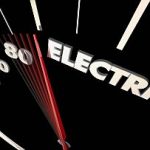
By Kate Harrison, MoveEV
August 30, 2023
The global shift towards electric vehicles (EVs) is reshaping the automotive industry and the increasing number of EV options. Thanks to operational savings and generous government EV adoption incentives, more businesses are considering incorporating EVs into their fleets than ever before. However, this transition comes with its own set of challenges. One significant hurdle is ensuring a reliable and convenient charging infrastructure.
While installing charging stations on-site is an option, it can be costly and time-intensive. A more pragmatic and cost-effective solution is to introduce a charging at home program for employees who drive EVs. Here are the top five reasons to encourage at-home charging:
1. Convenience
Employees who utilize company EVs will greatly appreciate the convenience of being able to charge their fleet vehicles at home. The accessibility of home charging eliminates the need to search for public charging stations, saving employees valuable time and reducing the hassle of planning routes around charging stops. According to a survey conducted by JD Power, 80 percent of EV owners prefer to charge their vehicles at home, underscoring the importance of convenient charging solutions for drivers.
2. Cost savings on electricity
A crucial benefit of a charging at home program is the potential for companies to save significantly on charging costs. Typically, electricity rates are lower during off-peak evening hours due to decreased demand. By encouraging employees to charge their EVs and PHEVs overnight, businesses can take advantage of these reduced rates. In many areas, like Baltimore where the off-peak rate is just $.09 per kWh, drivers who charge their vehicles at home can reduce a company’s fuel spend by 60 percent.
3. Reduced employee downtime
For businesses that rely on employee mobility, minimizing downtime is paramount. Employees who rely on public charging stations often encounter delays while searching for available working chargers, leading to extended breaks or even missed workdays. Even when available, public charging can take close to an hour, even when using a DC fast charger. Implementing a charging at home program eliminates this challenge for most fleet drivers, ensuring that employees can consistently start their workday with a fully charged vehicle.
4. Attracting and retaining talent
Prospective employees, especially from younger generations, are increasingly drawn to companies that offer EV-friendly policies as the move away from gas-powered vehicles spreads. In fact, almost two-thirds of millennials will not work at all for companies they do not consider to be socially responsible.
 By providing EV options to your fleet drivers and a charging at home program, your business can distinguish itself as a forward-thinking and environmentally conscious employer. An EV initiative can be a powerful tool for attracting and retaining top talent, particularly among individuals who have embraced a climate-conscious lifestyle.
By providing EV options to your fleet drivers and a charging at home program, your business can distinguish itself as a forward-thinking and environmentally conscious employer. An EV initiative can be a powerful tool for attracting and retaining top talent, particularly among individuals who have embraced a climate-conscious lifestyle.
5. Amplify environmental impact
In the pursuit of sustainability goals, businesses are seeking ways to minimize their carbon footprint. EVs, which have zero tailpipe emissions, align seamlessly with these objectives. A charging at home program that reimburses employees for their home electricity use makes choosing an EV fleet vehicle more attractive to employees, who would otherwise have to pay out of pocket to cover their home charging costs and might instead select a gas-powered vehicle. The cumulative effect of numerous employees adopting EVs through home charging can significantly contribute to reduced greenhouse gas emissions and air pollution.
Conclusion
 Embracing electric vehicles in your business fleet represents a pivotal step towards a more sustainable future. To ensure a seamless and efficient EV transition, a charging at home program offers unparalleled advantages. From enhanced convenience for employees to cost savings, reduced downtime, talent attraction, and amplified environmental impact, the benefits are undeniable. As the EV landscape continues to evolve, adopting a forward-looking charging strategy is not only a sound business decision, but also a testament to your commitment to innovation and sustainability.
Embracing electric vehicles in your business fleet represents a pivotal step towards a more sustainable future. To ensure a seamless and efficient EV transition, a charging at home program offers unparalleled advantages. From enhanced convenience for employees to cost savings, reduced downtime, talent attraction, and amplified environmental impact, the benefits are undeniable. As the EV landscape continues to evolve, adopting a forward-looking charging strategy is not only a sound business decision, but also a testament to your commitment to innovation and sustainability.





